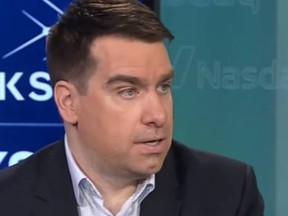Article content
This article was created by MoneyWise. Postmedia and MoneyWise may earn an affiliate commission through links on this page.


Get in now before the train takes off?

This article was created by MoneyWise. Postmedia and MoneyWise may earn an affiliate commission through links on this page.
After a disappointing start to 2022, stocks have shown resilience in the second half.
Since the end of June, the S&P 500 has surged nearly 10 per cent. And according to JPMorgan, there’s still more upside ahead.
The Wall Street gorilla recently reiterated its year-end price target of 4,800 for the S&P 500. With the benchmark index currently sitting at roughly 4,100, JPMorgan’s target implies a potential upside of 16 per cent.
The firm notes how lower market volatility can lead to inflows from systematic investors.
“Alongside corporate buybacks, these strategies can provide steady inflows of several billion per day in equities for the next 2-3 months,” writes Marko Kolanovic, chief global markets strategist at JPMorgan, in a note to investors. “Trend following strategies that were largely short equities this year are covering shorts.”
Let’s take a closer look at this call — and where the market guru sees opportunities.
Technical indicators could play a critical role in the potential turnaround.
Kolanovic points out that the S&P 500 “is on the cusp of breaking important momentum signals” such as the 200-day moving average.
On stock charts, the 200-day moving average is shown as a line. Traders can use this line to determine whether the trend is up or down and identify potential support or resistance areas.
The S&P 500 has largely traded below its 200-day moving average in recent months. Kolanovic suggests that if the index can break above this 200-day moving average, it could lead to inflows “on the order of ~$100 billion.”
We may have to wait a bit for that to happen. The S&P 500 fell 1.3 per cent on Friday and then tumbled another 2.1 per cent on Monday.
To tame spiking inflation, the Federal Reserve is raising interest rates aggressively, and that has cast a giant shadow over the stock market.
But Kolanovic doesn’t believe the central bank’s hawkish stance would persist.
“[W]e are again out of consensus and maintain that inflation will resolve on its own as distortions fade and that the Fed has overreacted with 75 bps hike,” he writes. “This Fed ‘overreaction’ and subsequent but largely unrelated decline in inflation will probably result in a Fed pivot, which is positive for cyclical assets.”
While JPMorgan has a bullish price target for the S&P 500, it does not suggest simply buying the benchmark index as a whole.
Kolanovic also cautions not to chase large-cap tech stocks or recession-proof stocks that are already “trading near all-time highs.”
The opportunities he sees are valuation-based.
“There are market segments such as energy trading at mid-single digit P/Es (below recession multiples), and even some broad markets such as the S&P 600 small cap index trading at recession level multiples,” he writes.
Investors can use ETFs to get exposure to these segments. For instance, the Energy Select Sector SPDR Fund (XLE) provides investors with convenient access to the energy sector of the S&P 500. Meanwhile, investors can use funds like the Vanguard S&P Small-Cap 600 ETF (VIOO) and the SPDR Portfolio S&P 600 Small Cap ETF (SPSM) to track the small-cap index.
Stocks can be volatile, cryptos make big swings to either side, and even gold is not immune to the market’s ups and downs.
That’s why if you are looking for the ultimate hedge, it could be worthwhile to check out a real, but overlooked asset: fine art.
Contemporary artwork has outperformed the S&P 500 by a commanding 174 per cent over the past 25 years, according to the Citi Global Art Market chart.
And it’s becoming a popular way to diversify because it’s a real physical asset with little correlation to the stock market.
On a scale of -1 to +1, with 0 representing no link at all, Citi found the correlation between contemporary art and the S&P 500 was just 0.12 during the past 25 years.
Investing in art by the likes of Banksy and Andy Warhol used to be an option only for the ultrarich. But with a new investing platform, you can invest in iconic artworks just like Jeff Bezos and Bill Gates do.
This article was created by Wise Publishing. Wise is devoted to providing information that helps readers navigate the complex landscape of personal finance. Wise only partners with brands it trusts and believes may be helpful to the reader. This article provides information only and should not be construed as advice. It is provided without warranty of any kind.
24World Media does not take any responsibility of the information you see on this page. The content this page contains is from independent third-party content provider. If you have any concerns regarding the content, please free to write us here: contact@24worldmedia.com

A Brief Look at the History of Telematics and Vehicles

Tips for Helping Your Students Learn More Efficiently

How To Diagnose Common Diesel Engine Problems Like a Pro

4 Common Myths About Wildland Firefighting Debunked

Is It Possible To Modernize Off-Grid Living?

4 Advantages of Owning Your Own Dump Truck

5 Characteristics of Truth and Consequences in NM

How To Make Your Wedding More Accessible

Ensure Large-Format Printing Success With These Tips

4 Reasons To Consider an Artificial Lawn

The Importance of Industrial Bearings in Manufacturing

5 Tips for Getting Your First Product Out the Door